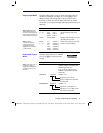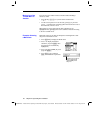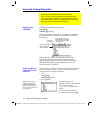
Chapter 2: Operating the Calculator 37
02OPER DOC TI
-
89/TI
-
92 Plus: O
p
erating the TI
-
89/TI
-
92 Plus (English) SusanGullord Revised:02/23/01 1:06 PM Printed: 02/23/01 2:11 PM Page 37 of 44
When you turn on the custom menu, it replaces the normal toolbar
menu. When you turn it off, the normal menu returns. For example,
from the Home screen’s normal toolbar menu, press
2
¾
to
toggle the custom menu on and off.
Home screen normal toolbar menu Custom menu
Unless the menu has been modified, the default custom menu
appears.
Menu Function
ƒ
Var
Common variable names.
„
f(x)
Function names such as f(x), g(x), and f(x,y).
…
Solve
Items related to solving equations.
†
Unit
Common units such as _m, _ft, and _l.
‡
Symbol
Symbols such as #, ?, and ~.
Internat’l
TI
.
89:
2
ˆ
TI
.
92 Plus:
ˆ
Commonly accented characters such as è, é,and ê.
Tool
TI
.
89:
2
‰
TI
.
92 Plus:
‰
ClrHome
,
NewProb
, and
CustmOff
.
If a custom menu other than the default is displayed and you want to
restore the default:
1. From the Home screen, use
2
¾
to turn off the custom
menu and display the Home screen’s normal toolbar menu.
2. Display the
Clean Up
toolbar menu,
and select
3:Restore custom default
.
TI
.
89:
2
ˆ
TI
.
92 Plus:
ˆ
This pastes the commands used to create the default menu into
the entry line.
3. Press
¸
to execute the commands and restore the default.
Using the Custom Menu
The TI
-
89 / TI
-
92 Plus has a custom menu that you can turn on
and off at any time. You can use the default custom menu or
create your own as described in Chapter 17: Programming.
Turning the Custom
Menu On and Off
Note: You can also turn the
custom menu on and off by
entering
CustmOn
or
CustmOff
in the entry line
and pressing
¸
.
Tip: A custom menu can
give you quick access to
commonly used items.
Chapter 17 shows you how
to create custom menus for
the items you use most
often.
Restoring the
Default Custom
Menu
Note: The previous custom
menu is erased. If that men
u
was created with a program
(Chapter 17), it can be
recreated later by running
the program again.
2
¾


















